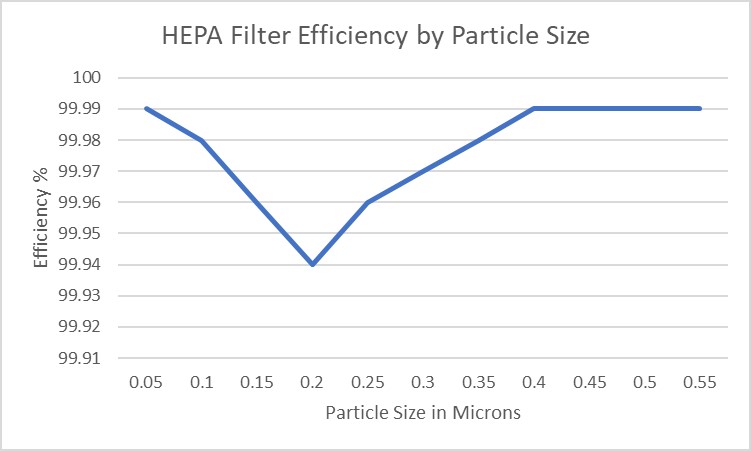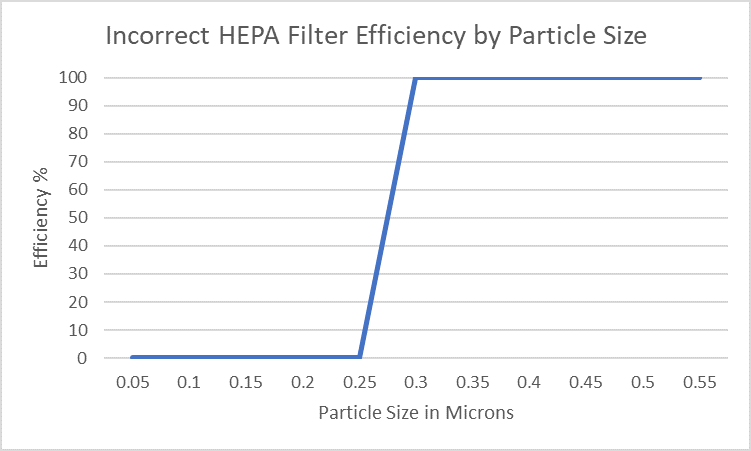By Jim Rosenthal, CAFS
“HEPA filters remove particles down to 0.3 microns. COVID-19 viruses are 0.125 microns so a HEPA filter cannot remove them from the air.”
The above statement is often found in news articles about COVID-19.
It is WRONG! HEPA filters remove over 99% of 0.125 micron sized particles!
Even in well researched pieces people keep making the same mistake. It is clear that there is a widespread misunderstanding of how air filters work. The purpose of this article is to give a concise explanation of how air filters remove particles and to clear up this misunderstanding.
Air filters capture particles by five mechanisms:
- Straining
- Impaction (Impingement)
- Interception
- Diffusion
- Electret charge
Most people think that all filters work on the basis of the first mechanism – straining. This is where the particle is too big to fit between two fibers and is pulled out of the airstream much like a colander catches noodles. This misconception is the basis for most of the problem in understanding air filters. We can intuitively understand this concept, since we use it frequently. But in actual fact, straining only accounts for about 1% of the particles captured by a filter.
The second filter mechanism is known as “impaction” or “impingement.” This is where the momentum of a particle forces the particle into the fibers of the filter. Here is a good way to think about how impaction works. Both water and air are “fluids.” They move in much the same way. Think of water in a stream. If leaves are in the current approaching a rock in the stream, they will move around the rock. However, if a log is in the current approaching the rock, it will run into the rock. The mass and momentum of the log enable it to continue moving in a straight line. The same thing happens with medium and large sized particles in an airstream. These particles are the “logs.” Impaction accounts for another 1% of the particles picked up by a filter.
The third mechanism of filtration is called interception. To understand this concept one needs be aware of how intermediate and small particles interact with fibers. All particles and fibers have a small positive or negative “charge.” Therefore, they have an inherent attraction to each other. This principle is known as “van der waal’s law.” Particles picked up by this method will “stick” to all parts of the fibers – the front, back and sides. Interception accounts for another 30-40% of the total particles removed from the air by a filter.
The fourth mechanism of filtration is called diffusion. The name comes from how small particles travel in the air. They do not travel in straight lines. They “diffuse” in the air stream and go in random oscillating paths (called Brownian motion). Therefore when they are in the matrix of the fibers of a filter, they will run into and be captured by those fibers. Diffusion accounts for the majority of particles removed by a filter.
The fifth mechanism is electret charge. This is where the filter fibers are “charged” so that they attract particles. The net effect is greater efficiency on smaller particles and lower resistance of the filter. HEPA filters are seldom, if ever, made to take advantage of this mechanism. Therefore, we will leave the discussion on the pros and cons of electret charged filters to a future blog post.
Keep in mind that over 98.5% of the number of particles in air are less than 1 micron in size. A micron is 1/25,400th of an inch (or one millionth of a meter). On the other hand 97% of the mass of the particles in the air is in particles over 1 micron.
Another important point is that all filters remove particles in all size ranges. All of the mechanisms of filtration are constantly working. The efficiency of filters in all size ranges varies substantially. Even a window screen will remove some of the smallest particles. And a HEPA filter will remove all of the largest particles.
With this basic understanding of how filters work, let’s look again at the oft repeated mistake on HEPA filters. (HEPA stands for High Efficiency Particulate Arresting filter.) The definition of a HEPA filter is one that “removes 99.97% of the particles at 0.3 microns.” The reason 0.3 microns is used is that this is the most difficult size of particle to remove. It is called the Most Penetrating Particle Size (MPPS).
For particles less than 1 micron the two filtration mechanisms that come into play are interception and diffusion. As the size of the particles go down, the effectiveness of interception decreases. On the other hand, in the smallest sizes diffusion is very effective but decreases as the size of the particles goes up. The result is an efficiency curve for a HEPA filter that looks like this:

If we assume the particle size of COVID-19 is 0.12um, the efficiency of a HEPA filter is 99.97%. It is not zero as many report in the media.
Let’s take a look at the efficiency curve for a HEPA filter as described in news articles:

Once one understands how filters work, it seems a bit ridiculous. The chart shows efficiency going from 99.97% at 0.3 microns to 0% at 0.25 microns. A HEPA filter will clearly capture an extremely high percentage of Covid-19 even assuming a 0.12 target particle size. And this is a big assumption. In all probability the target size for the virus is significantly higher. Here’s why:
Viruses do not “live” on their own. They invade organisms by taking over the RNA of their host. They are a parasite. An analogy that aptly describes their behavior is to think of viruses as “software.” The hosts they invade are the “hardware.” The current thinking is that the combination of viable viruses and the host is greater than one micron. Particles greater than one micron in size will still stay in the air for an extended period of time (several hours), but they are much easier for filters to capture than sub-micron size particles.
The biggest problem that HEPA filters have in capturing COVID-19 particles is not their size. It is the fact that they do not make it to the filter. A very good HVAC system might provide 6 Air Changes per Hour (ACH). This means that the equivalent volume of all of the air in the space will go through the system every ten minutes. A “super spreader” in a room is continuously giving off particles. So even in the best circumstances some people in a room could still be exposed. However, the probability of exposure is dramatically reduced. And at the end of the day that is what it is all about. In today’s pandemic world there is always the possibility of exposure. It is important to make decisions that reduce the probability of that exposure. HEPA filters are certainly a good option to do so.